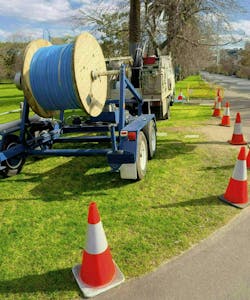Building smarter fiber networks
Key points are highlighted:
· Digital network documentation, coupled with advanced planning, Geographic Information System (GIS) systems, asset digital twins, and integrated management tools, can ease fiber deployments.
· The diversity of field conditions makes building a fiber network logistically challenging.
· Network documentation is the unsung hero of successful fiber builds.
By Stefanie Siegel / FNT Software
In today’s digital-first world, the demand for faster, more reliable internet is soaring. From remote work and online education to smart cities and IoT ecosystems, fiber optic networks are the backbone of modern connectivity. But building those networks isn’t easy. Fiber deployment is a high-stakes, high-cost process where mistakes can delay rollouts, inflate budgets, and jeopardize long-term performance.
As the pressure mounts to expand broadband coverage quickly and cost-effectively, a smarter, more integrated approach to fiber deployment is emerging. At the heart of this transformation is real-time, digital network documentation, coupled with advanced planning, Geographic Information System (GIS) systems, asset digital twins, and integrated management tools. These technologies help network operators move from manual, siloed processes to streamlined, data-driven strategies that cut risk, improve coordination, and accelerate time to revenue.
Why the build phase is critical
The build phase of a fiber project is where high-level designs become physical infrastructure. It’s also the most complex and resource-intensive stage. During this phase, crews trench roads, install conduits and poles, lay fiber, perform splicing, and install supporting equipment such as optical distribution frames and network cabinets.
Every action during the build affects the performance and scalability of the network for years to come. Any deviation from the plan—whether due to field errors, outdated documentation, or lack of coordination—can lead to costly rework, degraded signal quality, or even safety risks. The key to avoiding these pitfalls lies in having accurate, up-to-date information at every step.
Fiber construction challenges
Building a fiber network is logistically challenging. Field conditions can vary drastically between urban and rural environments. In cities, crews often contend with underground utilities, tight rights-of-way, and traffic control. In rural areas, rocky terrain and limited infrastructure pose different complications.
Permitting, utility coordination, and scheduling multiple contractors are additional hurdles. When data isn’t centralized or accessible to all stakeholders, miscommunication and duplication of work are common. Even minor issues, such as an incorrect splice or undocumented detour, can trigger delays that cascade through the entire project.
Furthermore, fiber cables and components require careful handling. Improper installation can result in signal loss or the need to re-splice connections, both of which increase costs and slow progress.
Cost and sustainability pressures
Financial efficiency is a critical concern. Underground fiber deployment in North America averages $16 per foot, while aerial installations cost around $6.50 per foot. Dense urban areas and rugged terrain can drive these figures much higher. A single mistake in planning can result in miles of unnecessary trenching, wasted materials, or delayed service availability.
At the same time, sustainability goals are pushing operators to minimize their environmental footprint. Fiber networks, especially passive optical ones, consume less power and require fewer active components than traditional copper infrastructure. But the deployment process itself, from trenching to hauling and installation, still generates significant emissions and material waste. That’s why more thoughtful planning and reuse of existing infrastructure is not only more economical but also more sustainable.
Network documentation’s role
Network documentation is the unsung hero of successful fiber builds. It starts well before the first trench is dug and continues through construction and beyond.
Pre-build documentation includes topology diagrams, site surveys, equipment specifications, and detailed routing plans. This ensures alignment across teams and helps crews prepare accurately for their tasks. Knowing the exact length of cable, location of splice points, and availability of ducts or poles reduces guesswork and helps avoid surprises.
During construction, documentation acts as both a guide and a real-time record. Field teams need current maps, fiber assignment tables, and instructions to ensure they’re installing infrastructure as designed. If a route must change in the field, perhaps to avoid an unexpected obstruction, being able to update the digital plan on-site ensures that future teams aren’t left guessing about what was built.
One compelling concept is the creation of an asset digital twin—a virtual replica of the physical network that mirrors its current status in near real-time, from cable routes and splices to active signal paths. When maintained properly, this digital twin becomes the authoritative source of truth for planning, troubleshooting, and future expansion.
Five must-have Tools for smarter fiber builds
Service providers that succeed in deploying fiber faster and more efficiently typically use five key digital tools:
1. Network planning software: Advanced design tools allow engineers to model fiber routes using real-world data. These platforms automate calculations, detect clashes with existing utilities, and optimize routes for cost and performance.
2. GIS mapping andinventory systems: A geographic information system (GIS) centralizes all asset data, both existing and planned. This visual interface enables crews to locate ducts, poles, splice enclosures, and fiber strands, making it easier to avoid duplicative work and identify reuse opportunities.
3. Asset Digital Twin technology: These virtual models reflect the live status of the network. They allow teams to simulate build scenarios, monitor progress, and ensure construction aligns with design specifications. They also help identify issues early, before they escalate.
4. Integration platforms: Connecting different systems (planning tools, GIS databases, mobile field apps) through APIs ensures that data flows automatically between stakeholders. When a crew updates a route in the field, that change is reflected in the central system, eliminating manual re-entry and reducing the risk of error.
5. Build management tools: Construction management software provides real-time dashboards, scheduling tools, and status tracking. These systems help allocate resources, monitor performance, and ensure that as-built data is captured digitally and accurately, streamlining the transition from construction to operations.
The benefits of an integrated approach
When these tools are used together in a connected environment, fiber deployment becomes significantly more efficient. Project managers gain real-time visibility into every aspect of the build, from the number of completed splices to the materials used on each street. Field crews receive accurate instructions and can log progress from mobile devices. Changes made on-site are instantly reflected in the digital model.
This integration reduces rework and errors caused by version mismatches or outdated plans. It also speeds up handoffs between engineering, construction, and operations. According to industry research, integrated approaches can accelerate fiber deployment by up to 20% and reduce build costs by as much as 25%.
Beyond speed and cost, integrated documentation improves quality and agility. Teams can simulate changes, troubleshoot issues faster, and plan for future upgrades with greater precision. With a well-maintained asset digital twin, the transition from build to operation is seamless and the network is easier to manage and expand over time.
The path forward
As global demand for high-speed internet accelerates, the pressure to deploy fiber faster, smarter, and more sustainably will only grow. Manual, fragmented processes simply can’t keep up with the scale and complexity of modern fiber rollouts.
A digitally integrated approach, centered around real-time documentation and collaboration, is rapidly becoming standard for successful builds. For network operators, investing in these capabilities isn’t just about technology; it’s about setting the foundation for long-term operational excellence. After all, a well-documented network is a high-performing network.
Stefanie Siegel, Product Manager at FNT Software, specializes in fiber optic projects and geospatial data visualization. For over 10 years, she has focused on simplifying network infrastructure management with innovative geoinformation solutions.

